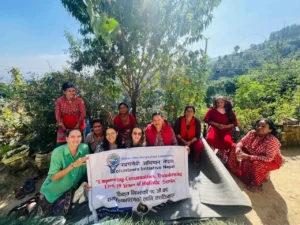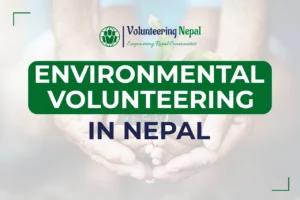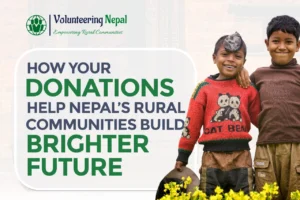
Sustainable Development Goals Nepal | SDG Progress 2030
Nepal committed to the Sustainable Development Goals (SDGs) in 2015, integrating the United Nations SDGs Nepal into its national framework to advance sustainable development in Nepal. Its Himalayan geography and socio-economic challenges shape its approach to SDG goals in Nepal.
This article explores the progress of the SDG in Nepal, the considerable challenges, and the strategic roadmap for the Nepal Development Agenda 2030.
Progress in Achieving SDGs in Nepal
In particular, Nepal has made significant progress toward achieving sustainable development goals 13 (SDGs) to reduce poverty and run economic development. The policies involving the country’s development have been pointed out, including the programs, targeted investments, personal livelihoods, and the bottom programs supporting widespread national progress—a closer look at these achievements.
Economic Growth and Poverty Reduction
Nepal’s economy grew 7% in 2019, driven by the agricultural sector, tourism, and remittances, per the National Planning Commission Nepal SDGs. Poverty fell from 31% in 2010 to 21% in 2021, supported by private sector-led microfinance programs empowering rural entrepreneurs. SDG Report Nepal highlights urban-rural disparities in SDG indicators in Nepal. Targeted interventions are needed to achieve equitable SDG targets in Nepal.
The private sector has boosted job creation, with 500,000 households accessing loans since 2015, fostering sustainable development in Nepal. The National Youth Agri Innovation Challenge has spurred youth-led businesses, aligning with UN Development Goals, Nepal. Yet, unemployment persists in remote regions. The Government of Nepal’s SDGs emphasize inclusive growth to address these gaps.
Education Improvements
Nepal’s literacy rate reached 67% in 2021, driven by public sector efforts like free primary education advancing Nepal education Support Volunteer. Community learning centers in Mustang enhance adult literacy through localized programs. The civil sector supports school infrastructure for SDG goals in Nepal. Inadequate facilities limit progress toward SDG 4 (Quality Education).
Non-governmental sectors have expanded access to education, with 10,000 community schools serving marginalized groups. Programs like the Urban Resilience Roadmap – Duhabi integrates education into urban planning, supporting SDG implementation in Nepal. Dropout rates remain high in mountainous regions. Investments in teacher training are critical for the sustainable goals of the Nepal government.
Health and Wellbeing
Child mortality has dropped from 42 to 28 per 1,000 live births since 2010, per UNICEF, reflecting SDG progress in Nepal. Public sector immunization programs, reaching 85% coverage by 2023, are supported by mobile clinics. Nepal’s health minister noted, “Health services are expanding for UN Development Goals, Nepal.” Rural areas still face gaps in specialized care.
The civil sector and NGOs, backed by private financing, have reduced maternal mortality by 20% since 2015, advancing SDG targets in Nepal. Community health initiatives improve access in remote regions. Malnutrition affects 30% of rural children, per SDG indicators Nepal. Scaling up infrastructure is vital for sustainable development in Nepal.
Environmental Conservation
Forest cover spans 40% of Nepal’s land, driven by community-led efforts and non-governmental sector support, aligning with the SDG goals for Nepal. Community-managed parks in Chitwan preserve biodiversity and generate income. These efforts support the Nepal government’s sustainable goals. Urbanization poses challenges to conservation, per the SDG report for Nepal.
The agricultural sector promotes sustainable agriculture goals through reforestation, backed by private-sector partnerships. Over 1,000 community forest groups monitor ecosystems, advancing SDG implementation in Nepal. Weather reversal threatens long-term benefits to SDG indicators per Nepal. Community involvement is the key to the goals of sustainable development in Nepal.
Challenges Hindering Progress
Despite the progress, Nepal faces significant challenges in achieving SDG due to its complex geography and underdeveloped infrastructure. These obstacles hinder basic services, transportation and trade and separate rural communities. Understanding these challenges is important for the future to create a practical, corporate and permanent development strategy.
Geographic and Infrastructure Barriers
Nepal’s mountainous terrain restricts road access to 36% of rural areas, a significant challenge for SDG implementation in Nepal. In districts like Humla, children walk hours to school, slowing SDG progress in Nepal. Infrastructure costs are high in remote regions. The public sector struggles to bridge connectivity gaps for UN Development Goals, Nepal.
Limited electricity access, affecting 60% of rural households, hinders economic and educational opportunities, per SDG Report Nepal. The Urban Resilience Roadmap – Duhabi improves urban infrastructure but excludes rural areas. Geographic isolation remains a considerable challenge. Investments in roads and energy are critical for sustainable development in Nepal.
Poverty and Inequality
Poverty persists at 18% in 2023, with rural and indigenous groups facing exclusion, hindering SDG targets in Nepal. Women earn 30% less than men in rural areas, per a 2022 World Bank report. The agricultural sector employs most people with low incomes but lacks modernization. Inequality threatens the sustainable goals of the Nepal government.
Social protection programs cover only 25% of vulnerable populations, per SDG Indicators Nepal. The civil sector advocates for marginalized groups, but the reach for the implementation of SDG in Nepal is limited. Economic inequality remains unchanged between urban and rural areas. The policies are needed to eliminate these significant challenges.
Environmental Threats
Himalayan glaciers, shrinking 30% by 2050, threaten water security and sustainable agriculture goals, per SDG report Nepal. A 2023 FAO report notes a 15% drop in Terai crop yields due to erratic weather. Pollution degrades ecosystems, impacting SDG goals in Nepal. These issues jeopardize SDG 2 (Zero Hunger).
Floods and landslides, intensified by climate change, disrupt rural livelihoods, slowing SDG progress in Nepal. The non-governmental sector promotes climate-resilient farming, but adoption is slow, per SDG indicators Nepal. Sustainable land-use policies are critical. Climate adaptation is vital for the goals of sustainable development in Nepal.
Policy and Funding Gaps
Achieving sustainable development goals in 2030 requires $4 billion annually, straining Nepal’s financing strategy. Weak coordination among the public and private sectors slows SDG implementation in Nepal. Experts call funding a considerable challenge. Multi-source financing is needed for SDG targets in Nepal.
Inconsistent data collection, with 60% of SDG indicators monitored in Nepal, hampers progress tracking. Bureaucratic delays affect rural project execution, per the National Planning Commission Nepal SDGs. The civil sector pushes for better governance. Streamlined policies and private financing are vital for goal attainment.
Vision and Strategies for 2030
Waiting 2030, Nepal’s vision to achieve the development of SDG centers on the development of the SDG centers, which does not leave anyone behind. The country aims to create a more elastic, righteous, and prosperous society for all its citizens by prioritizing the equivalent of resources, marginalizing, and strengthening local rule.
Focus on Inclusive Development
Nepal prioritizes marginalized groups, expanding health and education by localizing SDG goals. Women-led cooperatives in Dhading, supported by private sector funds, empower 5,000 families. Local governance drives inclusion for sustainable development goals 2030 Nepal. These efforts align with SDG 10 (Reduced Inequalities).
The National Youth Agri Innovation Challenge fosters entrepreneurship, engaging 10,000 youths since 2020 for UN Development Goals, Nepal. Over 200 municipalities adopt localization of goals, per the SDG report Nepal. Equitable resource access remains a priority. Civil sector initiatives will enhance Nepal’s education development.
Sustainable Natural Resource Use
Nepal aims to double its energy capacity by 2030 via hydropower, supported by private financing, advancing SDG goals in Nepal. Projects like Upper Tamakoshi support SDG 7 (Affordable and Clean Energy). Forest conservation protects 40% of the land. Sustainable resource use is central to the Nepal Development Agenda 2030.
The President Chure Conservation Program restores 1 million hectares, supporting sustainable agriculture goals. The agricultural sector promotes eco-friendly practices with support from the non-governmental sector. Community-led management is critical for sustainable goals by the Nepal government. Expanding renewable energy drives SDG implementation in Nepal.
Climate Change Adaptation
Nepal enhances flood defenses and climate-resilient crops to counter environmental threats, supporting SDG targets Nepal. Drought-resistant varieties in the Mid-Western region boost food security. Experts urge rapid adaptation for SDG 13, per SDG report Nepal. Climate risk integration is a strategic priority.
Early warning systems in 50 districts reduce disaster impacts, backed by multi-source financing. The Urban Resilience Roadmap – Duhabi strengthens urban climate planning for sustainable development in Nepal. Glacial melting requires urgent action. Proactive policies ensure resilient SDG progress in Nepal.
Strengthening Partnerships
The SDG National Steering Committee coordinates public, private, and non-governmental sectors for SDG implementation in Nepal. UNDP and private sector partnerships fund health and education initiatives. Data monitoring improves accountability for UN Development Goals, Nepal. SDG 17 relies on strong alliances.
Volunteer opportunities in Nepal, such as UN Volunteers, have engaged 10,000 participants in rural projects since 2015. NGOs like Volunteer Service Nepal offer international volunteer programs, fostering collaboration. Multi-source financing enhances resource sharing—coordinated efforts to accelerate sustainable development goals in 2030 Nepal.
Role of Local Communities and Volunteers
Local communities drive SDG progress in Nepal through cooperatives and conservation groups, with 2 million households engaged. The private sector and NGOs support volunteering in Nepal, including international volunteer programs in education and health. Work volunteer opportunities contribute to the localization of goals. These efforts strengthen the goals of sustainable development in Nepal.
Impact of Climate Change on SDGs
Climate change disrupts food security and water resources, with crop yields down 15% in Terai, per SDG report Nepal. Glacial melting threatens hydropower and irrigation, impacting SDG 6. The agricultural sector faces significant challenges. Climate adaptation is critical for sustainable development in Nepal.
Government’s Role in Sustainable Development
The National Planning Commission Nepal SDGs integrates SDG goals Nepal into the 15th Periodic Plan, focusing on the localization of goals. The Government of Nepal’s SDGs promote hydropower and rural development, but funding gaps persist. Streamlined governance is needed. The Nepal Development Agenda 2030 prioritizes sustainable growth.
International Support and Volunteering Opportunities
UNDP and non-governmental sectors provide support for United Nations SDGs Nepal. Funded by private financing, NGO volunteer opportunities engage 500 international volunteers annually in travel volunteer opportunities. These efforts enhance capacity. Partnerships drive sustainable development goals 2030 Nepal.
Conclusion
Nepal has reduced poverty, improved literacy, and expanded forest cover, but significant challenges like geography and climate change persist, per SDG Indicators Nepal. The private, public, and civil sectors must align for SDG targets in Nepal. A strategic roadmap with multi-source financing will ensure sustainable development in Nepal by 2030.
FAQs
How is Nepal working to achieve the 2030 Sustainable Development Goals?
A: Nepal integrates United Nations SDGs Nepal into national plans, with public and private sector collaboration driving the localization of goals.
Which sustainable development goals are most vital to Nepal’s progress?
A: SDG 1 (No Poverty), SDG 3 (Health), SDG 4 (Education), and SDG 13 (Climate Action) address considerable challenges for SDG goals in Nepal.
What progress has Nepal made toward meeting the SDGs by 2030?
A: Poverty fell to 21%, literacy rose to 67%, and forest cover reached 40%, but SDG indicators in Nepal show rural disparities.
What significant challenges does Nepal face in achieving the SDGs on time?
A: Geographic barriers, poverty, climate change, and funding gaps pose considerable challenges to SDG implementation in Nepal.
How does the Nepal government support sustainable development initiatives?
A: The Government of Nepal SDGs align SDG targets Nepal with national plans, promoting hydropower and localization, despite funding constraints.
What role do local communities play in Nepal’s SDG implementation?
A: Communities lead sustainable agriculture goals, with 2 million households engaged in sustainable development goals in Nepal.
How does climate change impact Nepal’s Sustainable Development Goals?
A: Glacial melting and erratic weather threaten food and water security, requiring robust strategies for SDG progress in Nepal.
What partnerships help Nepal advance the Sustainable Development Goals?
A: With UNDP support, public, private, and non-governmental sectors drive United Nations SDGs Nepal through volunteering in Nepal.
What is Nepal’s vision for sustainable growth by the year 2030?
A: Nepal envisions zero poverty and sustainability through hydropower, climate resilience, and localization for sustainable development goals in 2030 Nepal.



